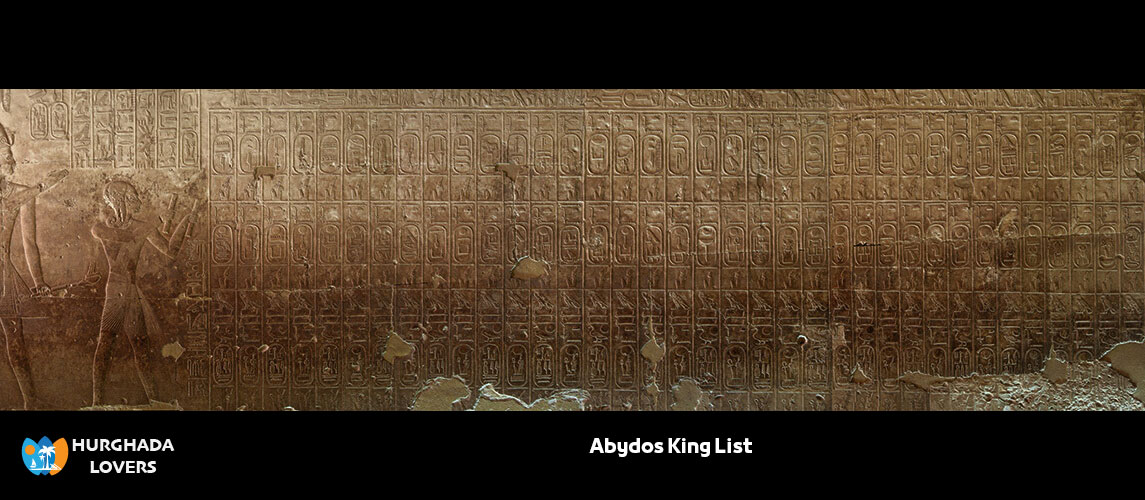Abydos King List | Facts Abydos Table of the of 76 Egyptian Pharaohs kings, History How many kings did ancient Egypt have
Facts, history and secrets of what the royal list contains of the names of the pharaohs of the ancient Egyptian families and more.
A list of kings in Abydos in Egypt was created in the past by the great Pharaonic king Seti I, who was one of the kings and rulers of the nineteenth dynasty. That was around 1300 BC. This list was inscribed on the walls inside his temple in the Abydos area.
Also, that great list contained the names of approximately 75 pharaohs who had ruled Egypt before the king ruled it for Pharaoh Seti I
The rulers who were present starting from the era of the first Egyptian dynasty, which began with King Mina Al-Hada, famous with a unified title, include both the Qataris, Al-Bahri and Al-Qibli.
That list ends, of course, with its owner and builder, King Seti I.
Also, that list did not mention a number of the names of the kings who had ruled Egypt during the first transitional period.
Hurghada lovers Offer Luxury Hurghada to Luxor Tours | El Gouna to Luxor Tours | Makadi bay to Luxor Tours | Sahl Hasheesh to Luxor Tours | Soma bay to Luxor Tours.
Abydos King List
What is the list of kings in Abydos?
● In fact, there are two lists in the archaeological area of Abydos, including the names of a large group of pharaohs who had assumed the rule of Egypt since the periods of rule during the era of the First Dynasty.
● One of these two pillars was established by King Pharaoh Seti I, who was one of the rulers of the Nineteenth Dynasty, and it was located in the heart of his ancient temple in Abydos.
● As for the second, it was established by the Pharaonic King Ramses II, which was also located within the scope of his temple in Abydos.
● In addition to all this, we can learn about the history of the great pharaohs through the presence of a number of other lists such as those engraved on the Palermo stone and the royal list that includes the names of the kings in Karnak.
● We also have a list of kings in Saqqara, and a list of kings in Abydos followed the list of King Ramesses II, as well as also by relying on the Turin Papyrus. And let us focus on the fact that these archaeological lists in Egypt are considered one of the most important sources through which it is possible to know the succession of rulers in Egypt during the periods of Pharaonic rule.
What’s on that Abydos King List
● That list in Abydos, that temple in which there is a very long corridor that in turn leads to the royal hall, where the Pharaonic king at that time ordered the engraving of a number of cartouches in which the names of the kings in Egypt who had assumed power before him were engraved.
● It is also engraved on the left side in the same temple, and from that large list is a picture representing Pharaoh Seti I while he was standing, and then how many directly in front of him was his young son, King Ramses, who was later to become King Ramses II.
● And that image was referring to Pharaoh Seti, who knew his son by the names of the crowds of those kings who had ruled Egypt before them.
the kings mentioned in Abydos King List
● In fact, those cartouches in the temple include the names of a number of well-known Egyptian kings, especially before the reign of Seti I directly
● Their number was 76 kings, the first of them, of course, was King Mina, and it continued to follow until it reached King Seti I.
● But what is important to mention is that the names of the masses of those rulers who had already ruled Egypt during the rule of the two transitional periods, along with the names of five kings of the Eighteenth Dynasty, were not mentioned or mentioned, for many reasons that may be political or religious.
● And those who did not mention were Queen Hatshepsut, who had assumed power before the Pharaonic king Thutmose III, who was still young at that time, and her name was then crossed out from all the walls of the temples that were in an ancient era about that period.
● Or does Akhenaten also mention, since he was the one who had replaced the multiplicity of Egyptian gods in the era of the Pharaohs with the worship of only one god, who is the Aten represented by the disk of the sun?

